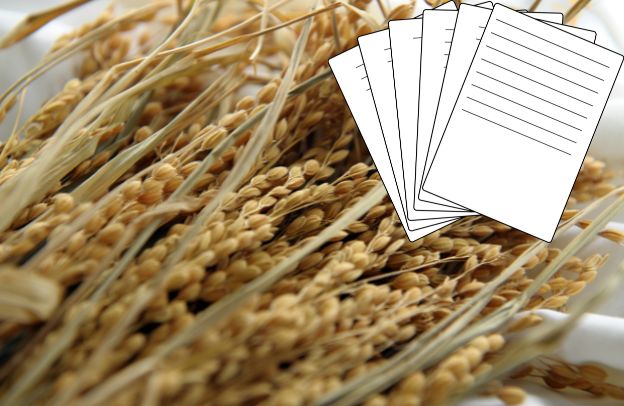Cultivating Rice For The Production Of Biofuel

Rice is not only a staple food for many people around the world, but it also has a variety of industrial uses. One of the most promising and sustainable uses for rice is as a biofuel. Rice straw, a byproduct of rice cultivation, can be processed and used to generate electricity and heat.
Get a FREE GUIDE for your small and medium-scale farming business.
Cultivate rice for the production of biofuel
Rice straw is a highly abundant and renewable resource, making it a perfect candidate for biofuel production. It contains a high amount of cellulose, hemicellulose, and lignin, which can be converted into biofuels such as ethanol and biogas.
This process not only reduces the amount of waste produced during rice cultivation but also provides a sustainable and renewable energy source.
The use of rice straw as a biofuel also has numerous environmental benefits. It reduces the need for fossil fuels, which are a major contributor to air pollution and climate change. Additionally, it reduces the amount of rice straw that is burned or left to decompose, which can also contribute to air pollution and contribute to greenhouse gas emissions.
How to extract biofuel from rice
The process of converting rice straws into biofuels is relatively simple and cost-effective. It involves breaking down the straw into small pieces and then using enzymes or bacteria to convert the cellulose, hemicellulose, and lignin into biofuels. This process can be done at a small scale, making it accessible to farmers and small-scale producers.
The use of rice straw as a biofuel is already being implemented in many countries around the world. In Asia, where rice is a major crop, rice straw is being used to generate electricity and heat in rural areas. In Europe and North America, research and development are ongoing to increase the efficiency and scalability of the process.
The use of rice straw as a biofuel is a sustainable and environmentally friendly way to reduce waste and generate renewable energy. It has the potential to reduce dependence on fossil fuels and contribute to a cleaner and greener future.
With ongoing research and development, the use of rice straw as a biofuel has a promising future as a viable alternative energy source.
The economic value of cultivating rice for the production of biofuel
The cultivation of rice for the production of biofuels can have a significant impact on the economy in several ways:
- Job creation: The production of biofuels from rice can create new jobs in the agriculture, manufacturing, and transportation sectors, providing economic opportunities for local communities.
- Increased agricultural production: The cultivation of rice for biofuels can increase the demand for rice, leading to higher prices and increased production. This can provide a boost to the local agricultural economy and support farmers’ livelihoods.
- Energy security: By producing biofuels from locally grown crops like rice, countries can reduce their dependence on imported fossil fuels and increase their energy security. This can reduce the cost of energy and improve the trade balance, providing economic benefits to the country as a whole.
- Reduction in greenhouse gas emissions: Biofuels produced from rice can help to reduce greenhouse gas emissions, contributing to efforts to combat climate change. This can provide environmental and economic benefits, as well as help protect the planet for future generations.
- Development of new technologies: The production of biofuels from rice can spur the development of new technologies, including new cultivation and processing methods, and new equipment and machinery. This can drive innovation and economic growth in the agricultural sector.
However, it is also important to consider the potential economic costs and challenges associated with cultivating rice for biofuels. These can include increased competition for land and resources, and potential impacts on food security.
It is crucial to carefully evaluate the trade-offs and implement policies that ensure the sustainable production of biofuels from rice and promote economic and social development.
What is the environmental sustainability of bioethanol production from rice
The production of bioethanol from rice has both environmental benefits and drawbacks. Here are some of the key benefits:
- Reduced greenhouse gas emissions: Bioethanol production from rice can help to reduce greenhouse gas emissions compared to fossil fuels, as the crops absorb carbon dioxide from the atmosphere during growth.
- Renewable energy source: Rice bioethanol is a renewable energy source that can be produced from crops grown annually, reducing dependence on finite fossil fuels.
- Improved soil health: Rice cultivation for bioethanol production can improve soil health, reducing the need for chemical fertilizers and pesticides, and promoting sustainable agriculture.
There are equally some drawbacks to bioethanol production from rice. Here are some for your consideration:
- Land use: The cultivation of rice for bioethanol production can compete with food crops for limited land and resources, potentially leading to food scarcity and higher food prices.
- Water use: Rice cultivation is water-intensive, and the production of bioethanol from rice can strain already scarce water resources, particularly in regions where water is limited.
- Input requirements: The production of bioethanol from rice requires significant inputs such as fertilizer and pesticides, which can have negative impacts on the environment if not managed properly.
- Transportation emissions: The transportation of rice and bioethanol can generate emissions, potentially offsetting the emissions savings achieved through biofuel use.
Overall, the environmental sustainability of bioethanol production from rice depends on a number of factors, including the methods used for cultivation, the type of rice used, and the overall production process.
Careful planning and management are necessary to ensure that the production of bioethanol from rice is both economically and environmentally sustainable.
Conclusion on cultivating rice for the production of biofuel
In conclusion, cultivating rice for the production of biofuels has the potential to provide a range of economic and environmental benefits. The increased demand for rice can provide a boost to the agricultural sector, create new jobs, and reduce dependence on imported fossil fuels.
The production of bioethanol from rice can reduce greenhouse gas emissions, promote sustainable agriculture, and spur technological innovation.
However, it is important to consider the potential costs and challenges associated with this approach. The cultivation of rice for biofuels can compete with food crops for limited land and resources, and can also strain already scarce water resources. The production of bioethanol requires significant inputs, such as fertilizer and pesticides, which can have negative impacts on the environment if not managed properly.
Therefore, careful planning and management are necessary to ensure that the production of bioethanol from rice is economically and environmentally sustainable. This may involve implementing policies that promote sustainable agriculture, improving the efficiency of the production process, and investing in new technologies to reduce inputs and emissions.
By carefully balancing the economic and environmental benefits and costs, the cultivation of rice for biofuels can be an important part of a more sustainable future for all.
Are you a small or medium-scale farmer? Then get our FREE GUIDE for your farming business.






